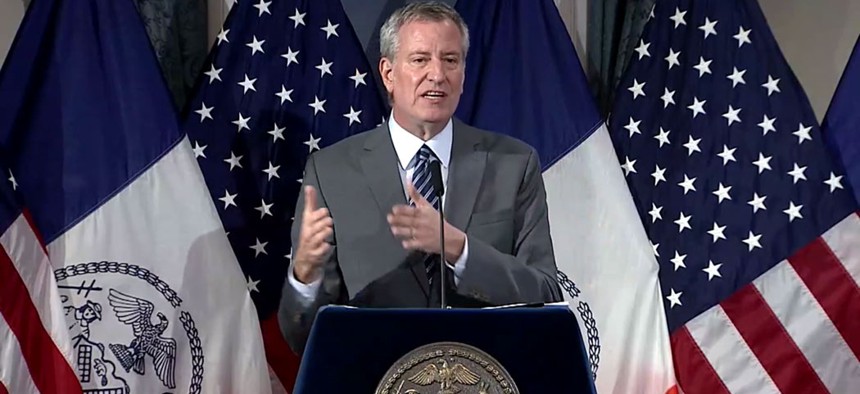A giant question mark hung over New York City Mayor Bill de Blasio’s fiscal year 2021 preliminary budget announcement on Thursday: How would potential state budget cuts affect the city? Gov. Andrew Cuomo’s executive budget presentation, planned for next Tuesday, is expected to explain how the governor will close the state’s $6.1 billion budget gap – which should, in turn, shed some light on how much the city might be forced to bear the brunt of state cuts.
“The word preliminary is crucial in this case,” de Blasio said at the press conference at City Hall, “but it will be very deeply determined by what happens between now and April 1” – the date the state budget is due. “We’ve never seen this kind of threat from the state budget.”
Whatever the future holds, de Blasio gave some cold hard numbers. Here are the highlights:
$95.3 billion: What goes up but never comes down? Age, and New York City’s budget. The expense budget has gone up every year of de Blasio’s mayoralty, but since the city is legally required to provide a balanced budget, the increase in spending is offset by huge increases in revenue as the city rides a period of economic growth.
$6.1 billion: That’s the expected state budget deficit, and Cuomo suggested in his State of the State address that he plans to close the gap by redesigning the state Medicaid program – which de Blasio fears could mean more spending for the city to pick up.
1,000: The number of new employees the city plans to hire to help implement state criminal justice reforms, which went into effect on Jan. 1. In total, the city is attributing $175 million in increased spending to the law, which limits the use of cash bail and requires prosecutors and courts move faster to try suspects and disclose evidence earlier, before and during trial.
80%: The percentage of the city’s workforce that’s currently under a labor contract. These new contracts, many of which include 8% raises for workers over three years, are the cause of $1.6 billion in increased spending in the current fiscal year 2020.
$1.25 billion: The amount of money in the city’s budget reserves, including $1 billion in the general reserve and $250 million in the capital stabilization reserve, or about the same as last year. The city also has $4.7 billion stowed away in the Retiree Health Benefits Trust Fund. As has become a tradition in recent years, the business-backed fiscal watchdogs at the Citizens Budget Commission urged the mayor to sock away more towards the reserves.
0: The number of new marquee spending proposals introduced in the executive budget. With de Blasio urging caution, the best he could scrounge up for the announcement were relatively small investments, like $98 million towards improving street safety on Brooklyn’s 4th Avenue and $12.9 million towards improving community centers at New York City Housing Authority developments.
July 1: The first day of the city’s new fiscal year, and the day the final budget is due. In recent years, the mayor and the New York City Council have reached a budget deal as much as two weeks before the deadline. But if de Blasio’s fears of state budget cuts are confirmed, this year could bring fraught negotiations.


